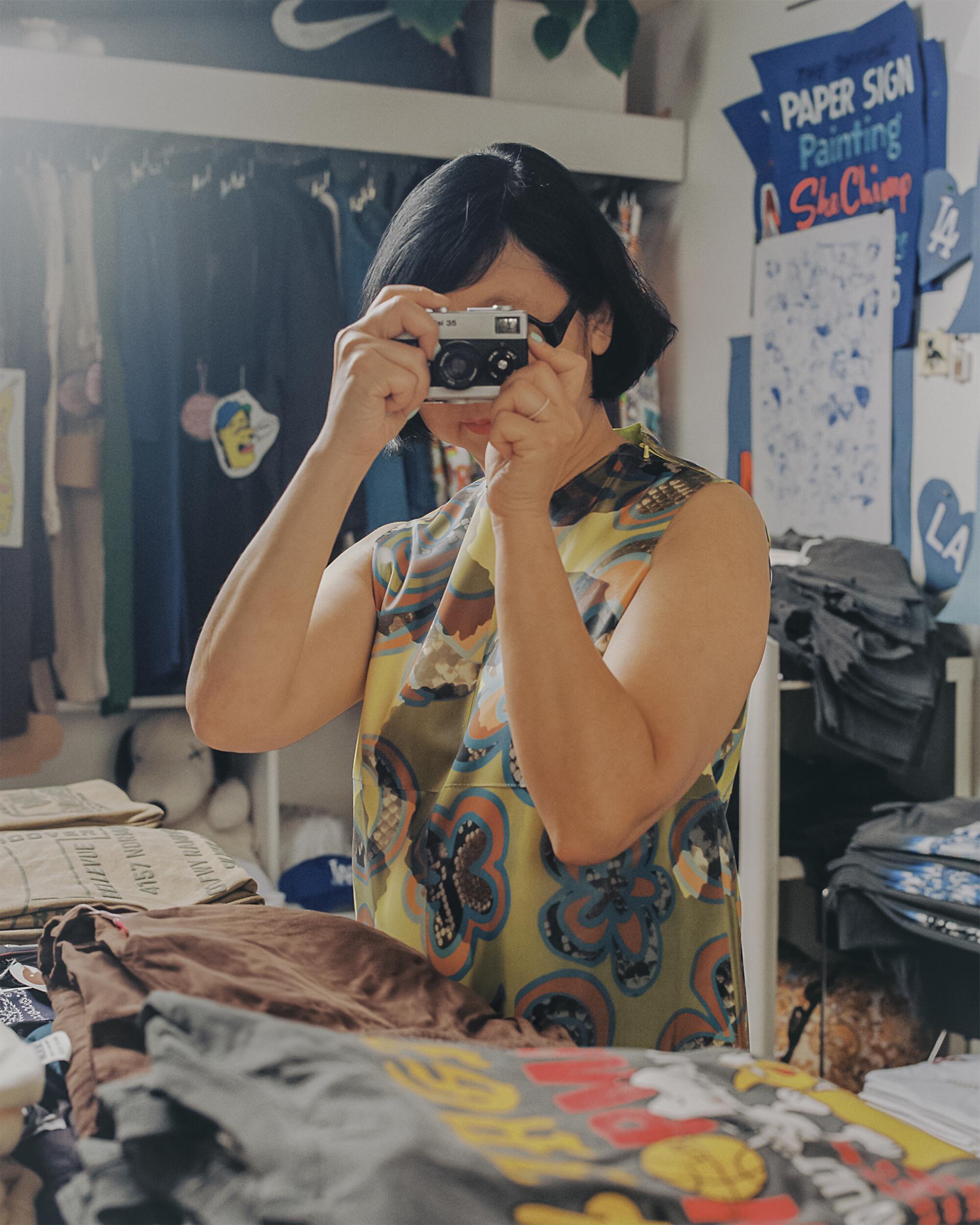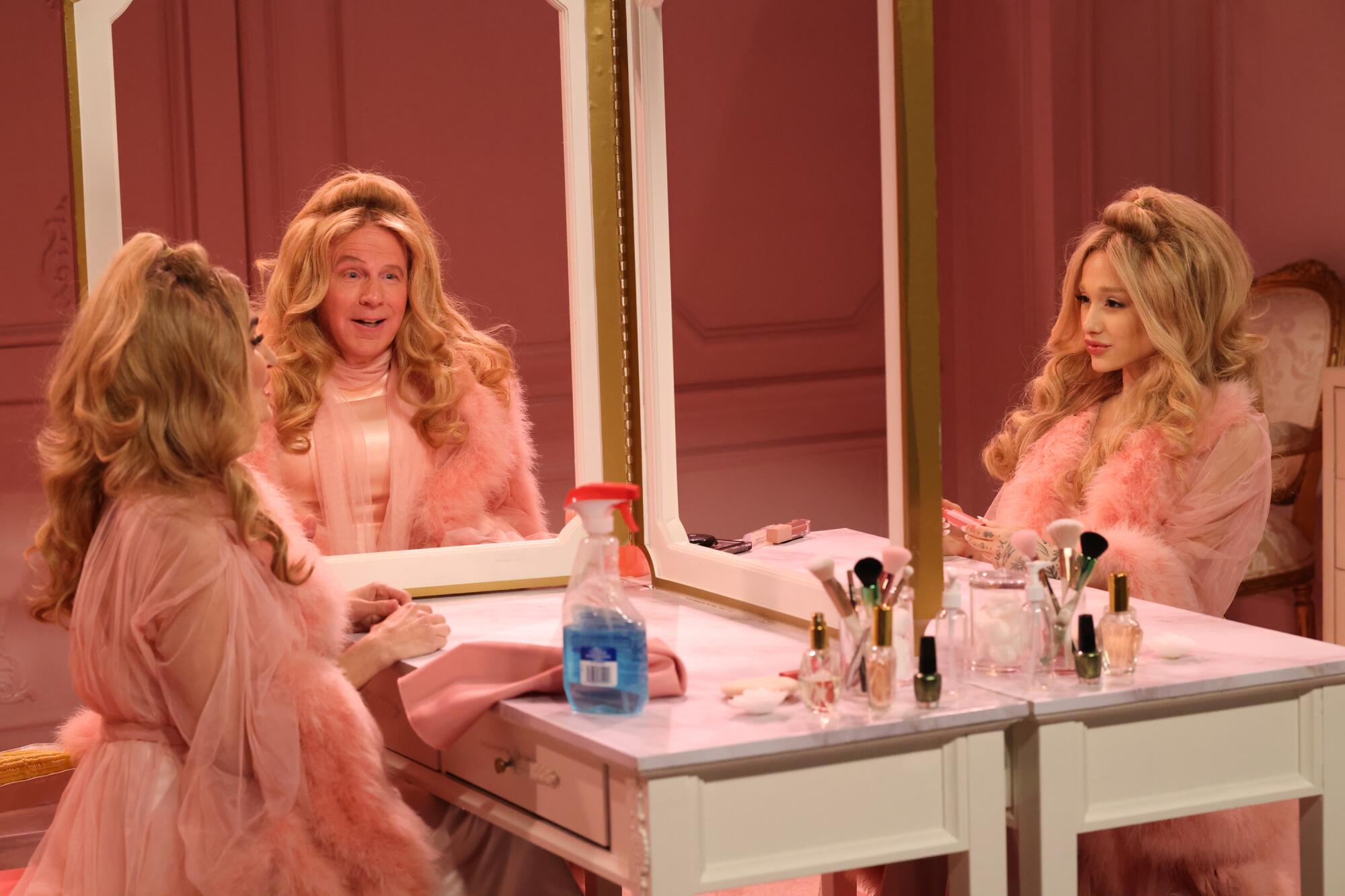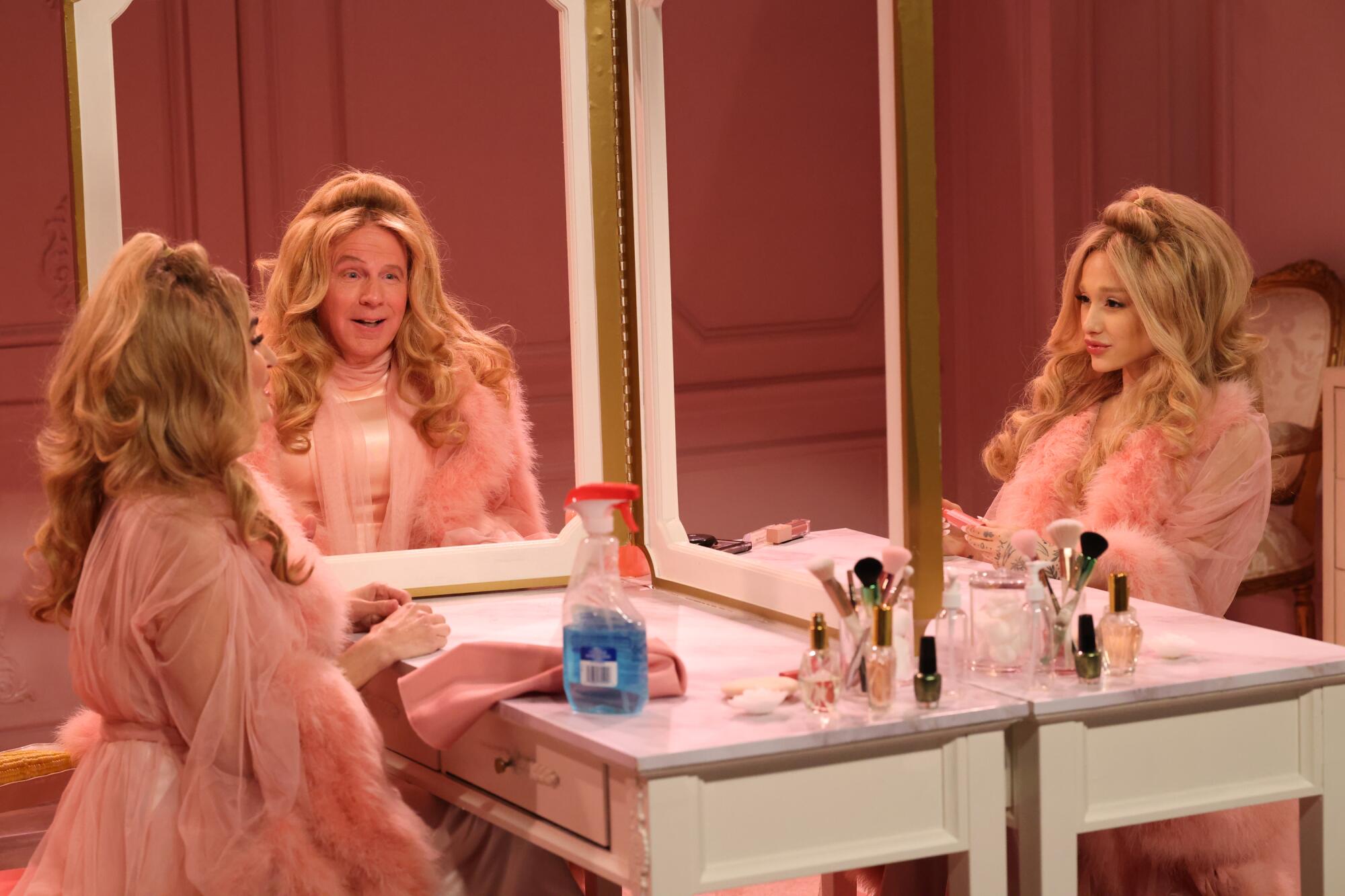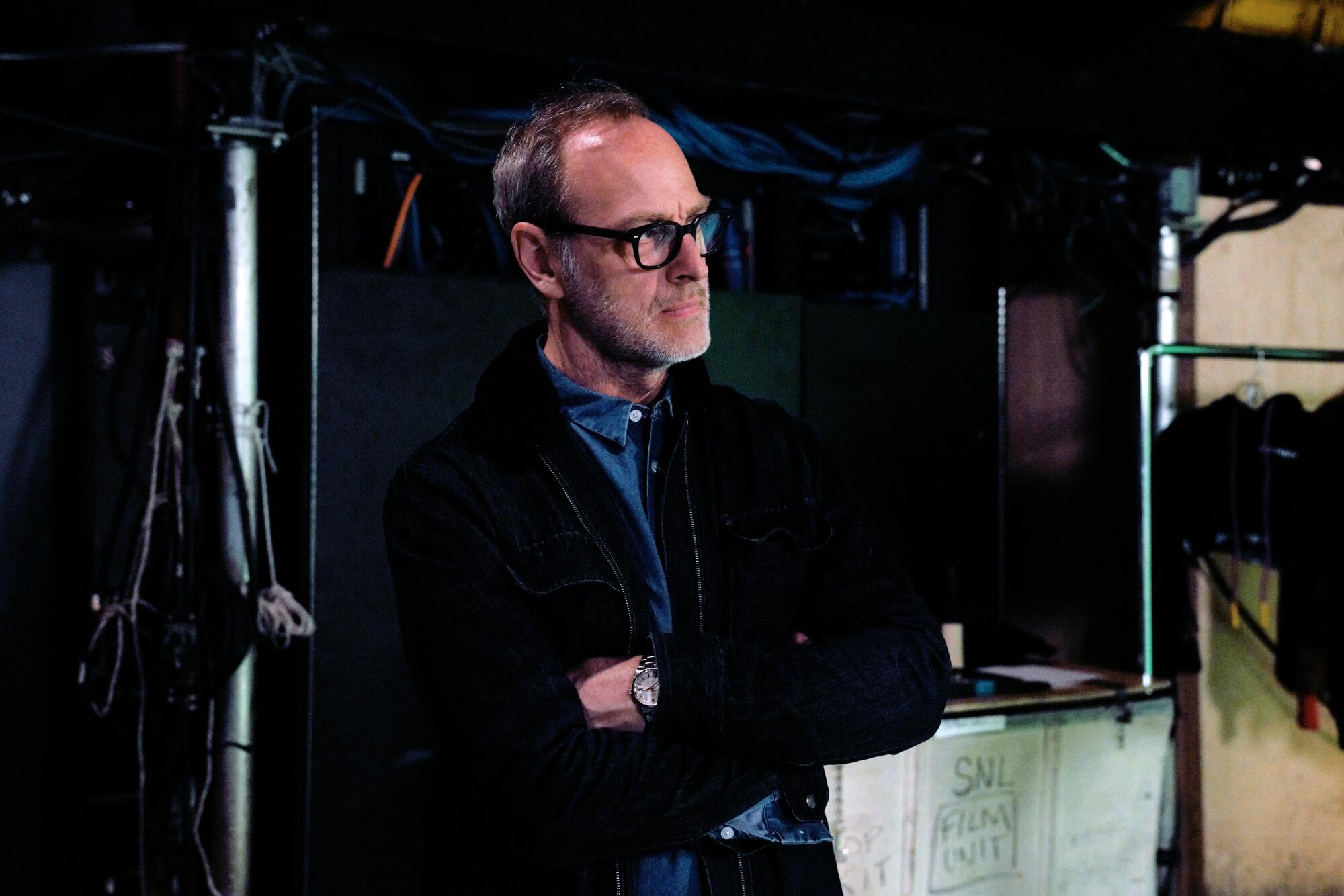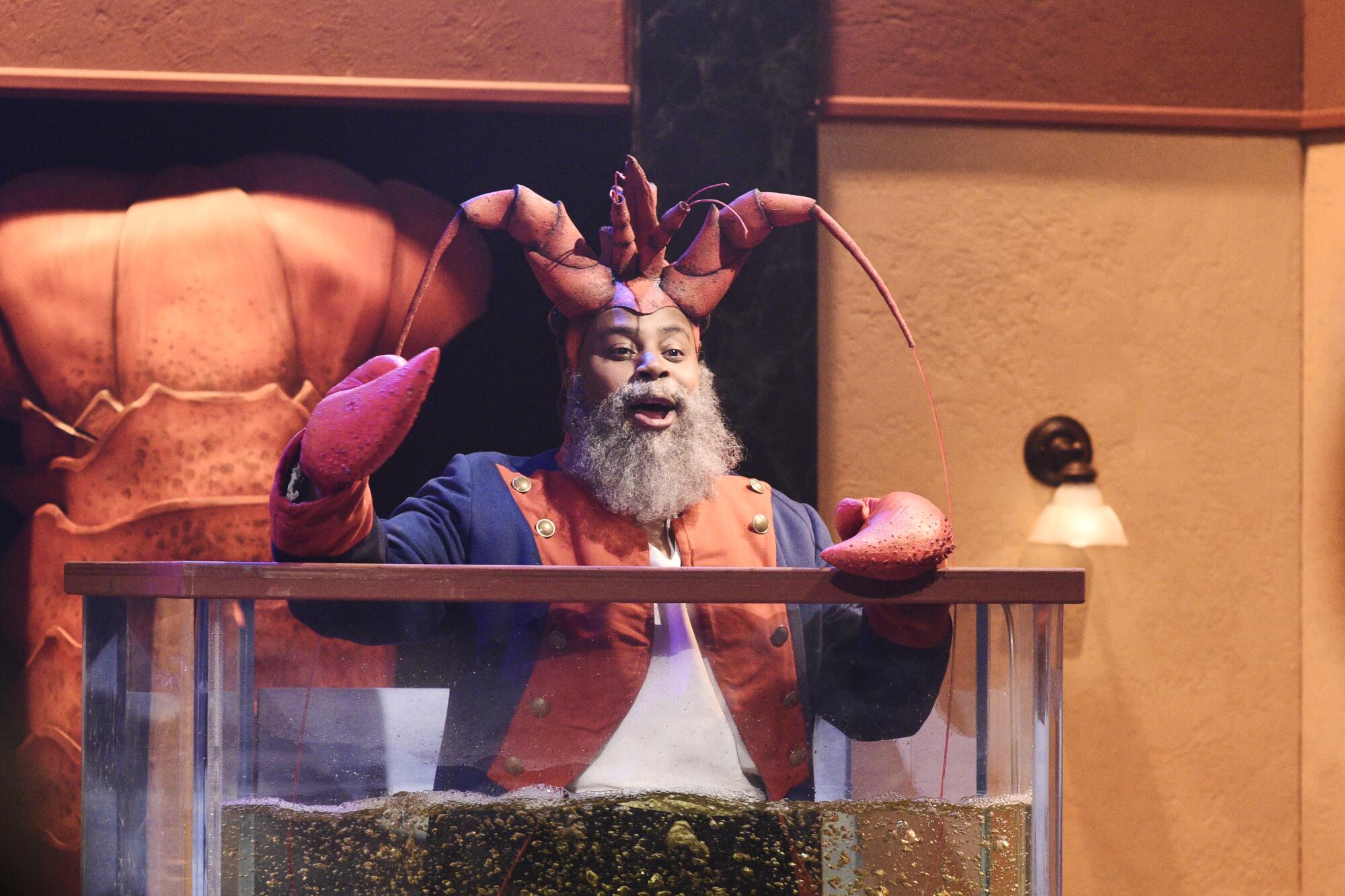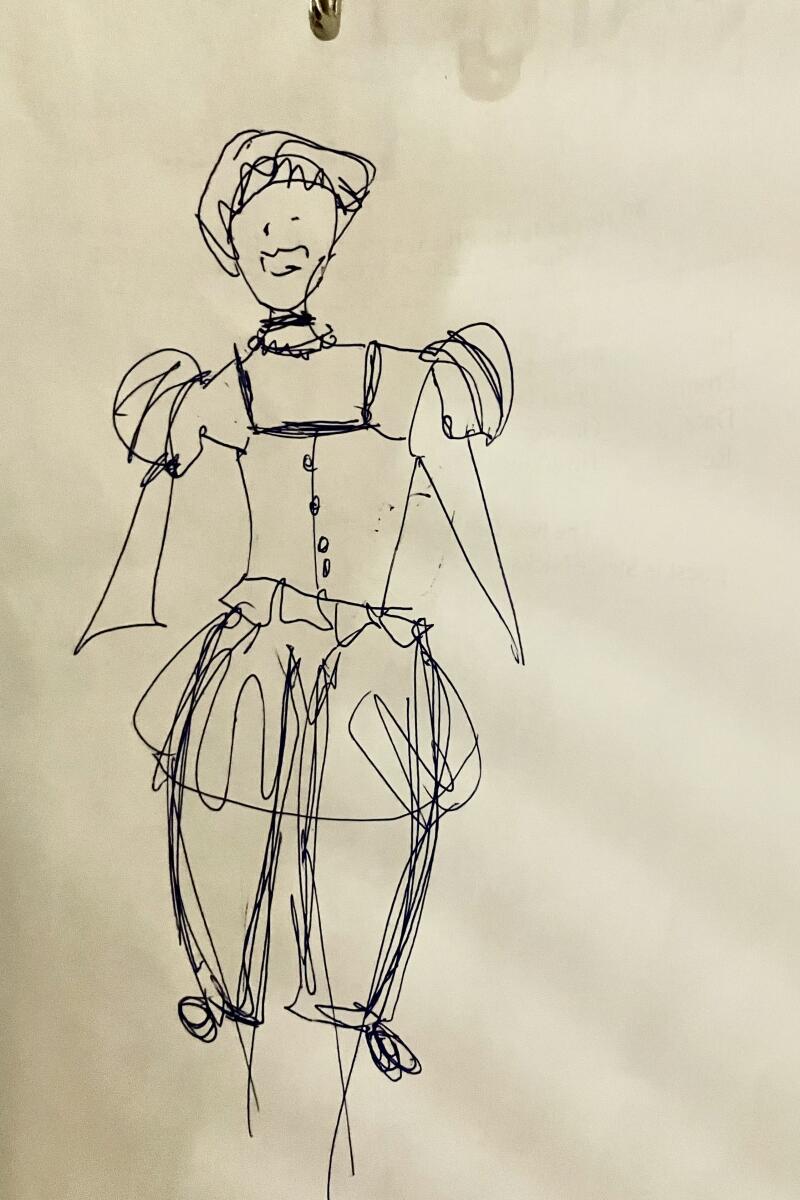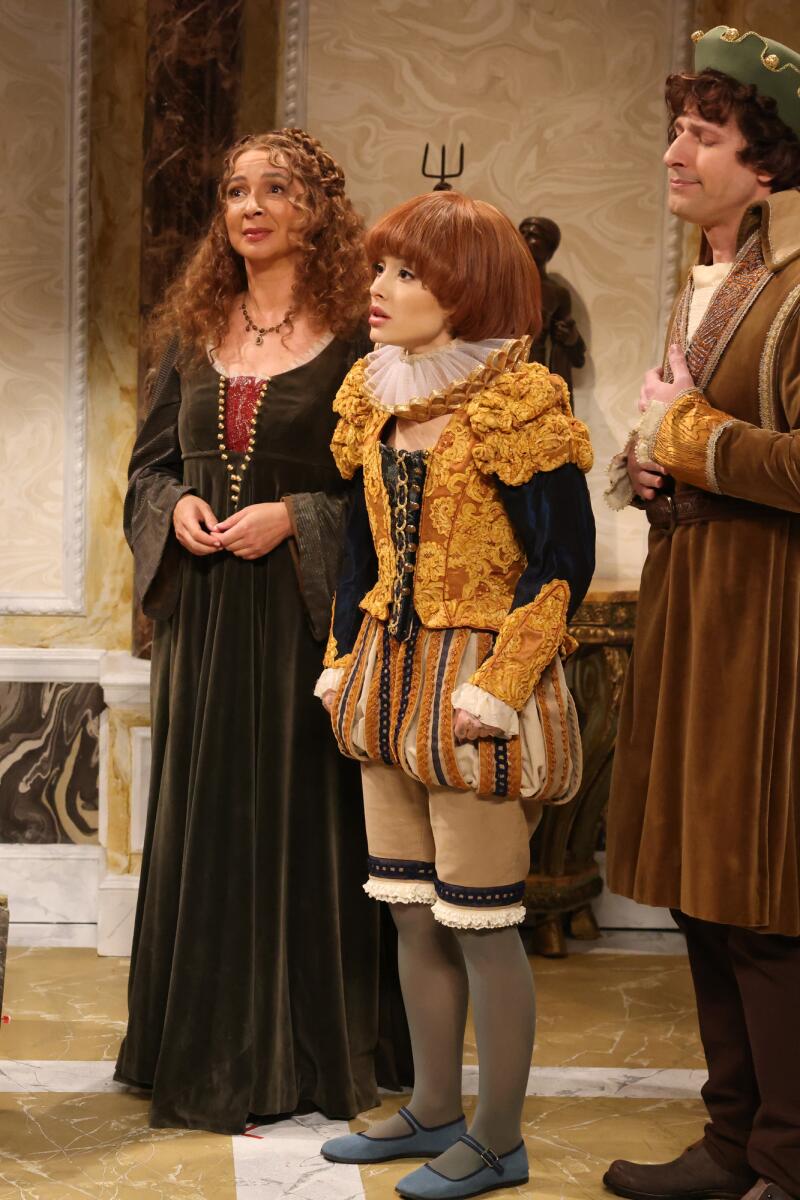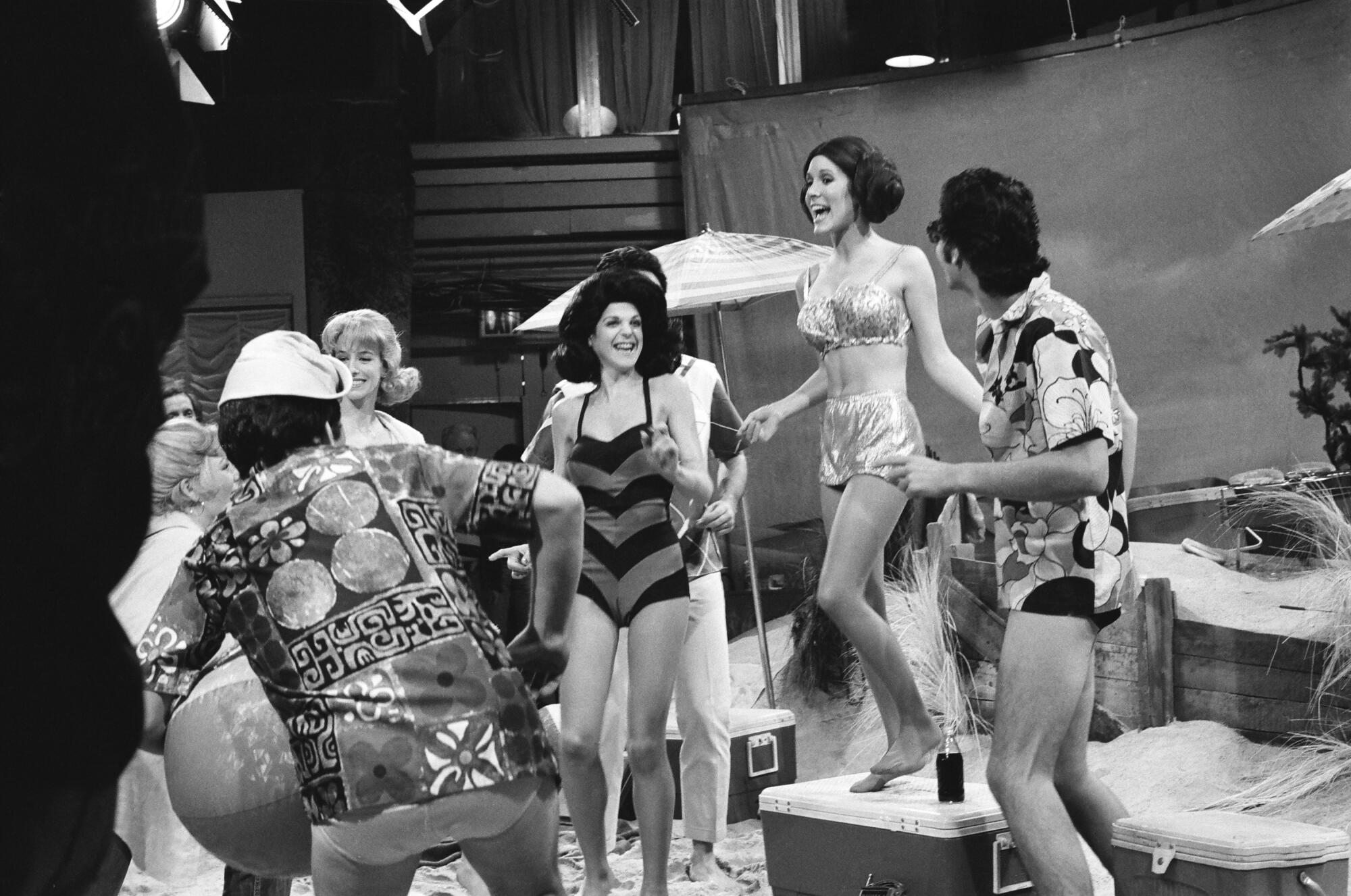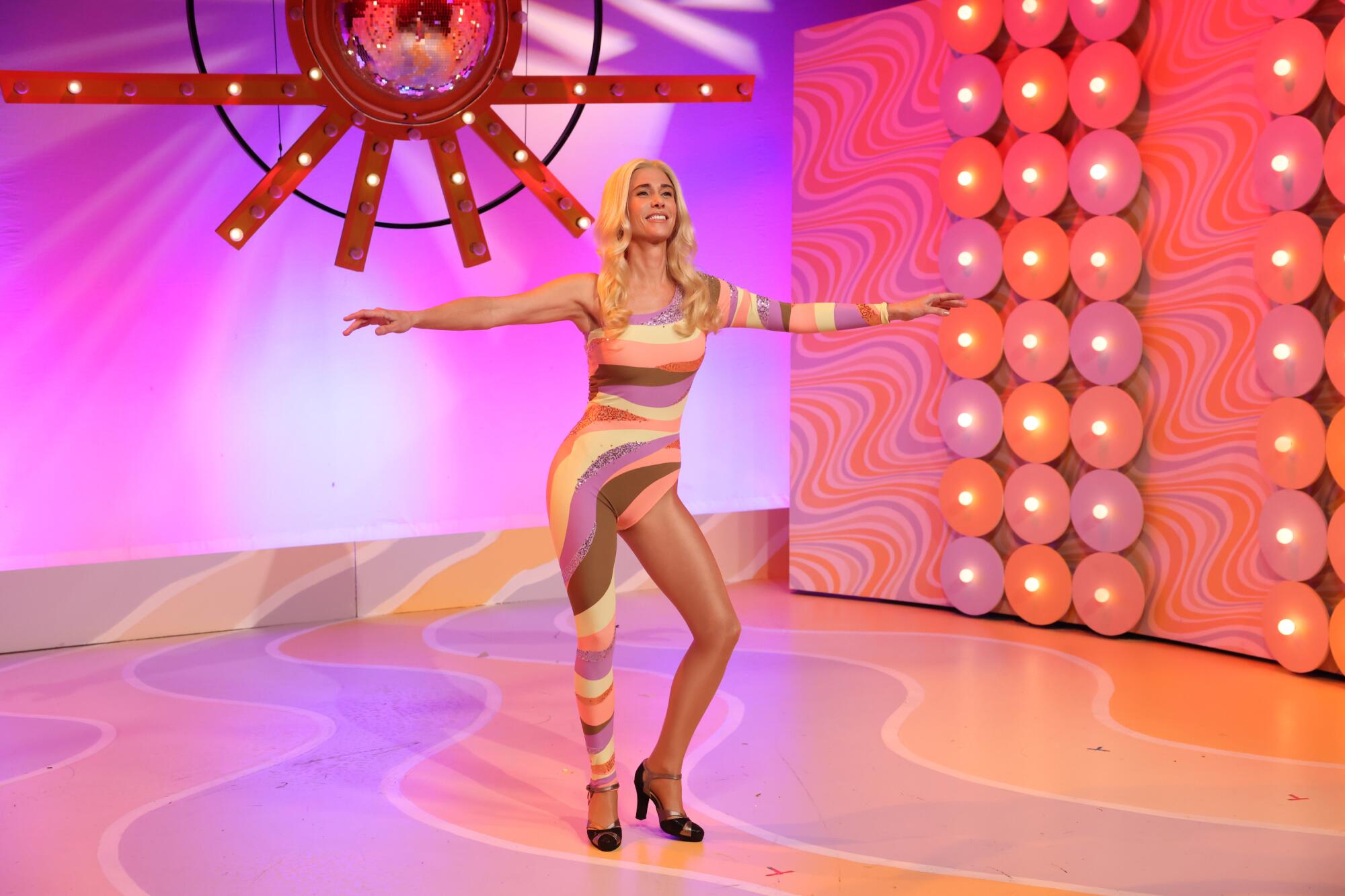Costume designer Shirley Kurata on fashion and growing up in L.A.
To live in Los Angeles is to be a seeker. There are those who come to the city in search of the limelight and affluence. There are others who crave temperate weather and long for accessible beaches. The list goes on. Some of these desires are easily satisfied, while others are left unfulfilled or forgotten. But for those born and raised in this atypical metropolis, like Shirley Kurata, the search is never-ending.
The costume designer tells me the key to loving this city is to never stop venturing around. We sit in the shaded back patio of Virgil Normal, a 21st century lifestyle shop she owns with her husband, Charlie Staunton. She wears a vibrant pink getup — a vintage top and Issey Miyake pants — complete with small pleats and optimal for the unavoidable August heat wave. Her signature pair of black circular glasses sits perfectly on the bridge of her nose. It’s a style of eyewear she owns in several colors.
“I always tell people, L.A. is like going to a flea market. There’s some digging to do, but you’ll definitely find some gems,” says the stylist and costume designer, as she’s regularly on the lookout for up-and-coming creative hubs and eye-catching storefronts. “It won’t be handed to you. You have to dig.”
In one way or another, “digging” has marked Kurata’s creative livelihood. Whether she’s conjuring wardrobes for the big screen, like in the Oscar-winning “Everything Everywhere All at Once,” or styling musicians like Billie Eilish, Florence and the Machine and ASAP Rocky for photo shoots and music videos, the hunt for the perfect look keeps her on her toes.
Over the summer, Kurata spent a lot of time inside the Costco-size Western Costume Co., pulling looks for Vogue World, the magazine’s annual traveling runway extravaganza. This year, the fashion spectacle is centered around Hollywood and will take place at Paramount Pictures Studios in late October. She is one of the eight costume designers asked to present at the event — others include Colleen Atwood of “Edward Scissorhands,” Ruth E. Carter of “Black Panther” and Arianne Phillips of “Once Upon a Time in Hollywood.” Kurata will be styling background performers and taking inspiration from the invited costume designers.
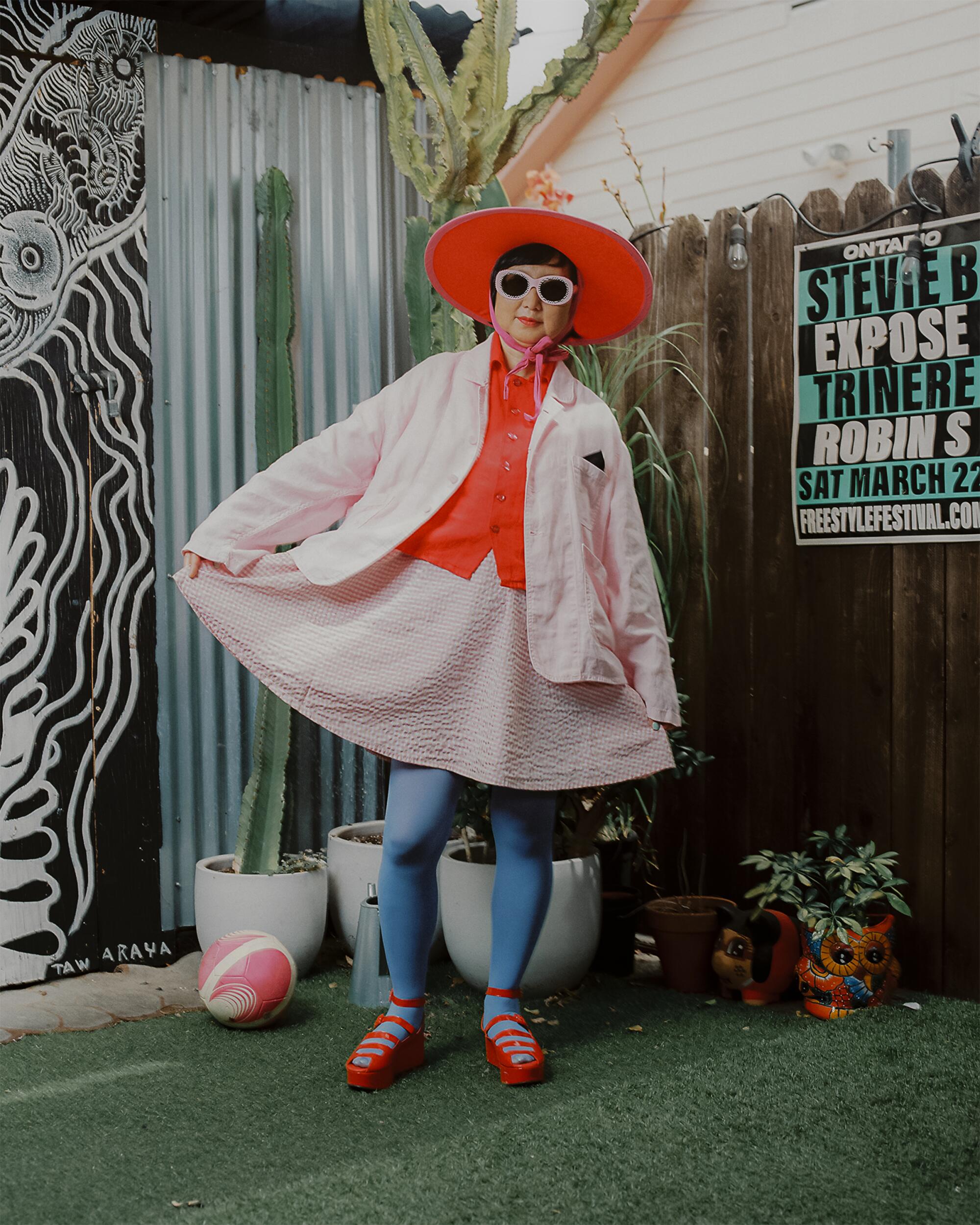
Shirley wears vintage hat, Meals Clothing top, shirt and dress, We Love Colors tights, Opening Ceremony x Robert Clergerie shoes and l.a. Eyeworks sunglasses.
“[Vogue] wanted someone that is a stylist and costume designer who has worked both in fashion and film. Because a lot of costume designers work primarily in TV and film, they don’t do the fashion styling for editorial shoots,” says Kurata. “I’m coming on and working with what other costume designers have done.”
Since her start in the business, Kurata has gained acclaim for her ability to infuse daring prints and vibrant color into the narrative worlds she deals with. Her maximalist sense of experimentation took center stage in “Everything Everywhere All at Once” and earned her an Academy Award nomination for costume design. From a bejeweled Elvis jumpsuit to a look made entirely of neon green tassels meant to resemble an amoeba, her vision was avant-garde, playful and undeniably multidimensional.
When Kurata isn’t on set or in the troves of a costume house, she’s likely tending to Virgil Normal. Housed in a former moped shop, the Virgil Village store offers a selection of novelty items and streetwear treasures, curated by both Kurata and Staunton. Though Staunton jokes that he’s constantly seeking her approval when sourcing inventory: “If it’s not cool enough for her, it doesn’t come in.”
The couple first met at the Rose Bowl Flea Market through mutual friends. At first sight, Staunton recalls being enthralled by her perpetually “cool” demeanor. Early in their relationship, he even floated the idea of starting a clothing line together, just to “knock off her closet.”
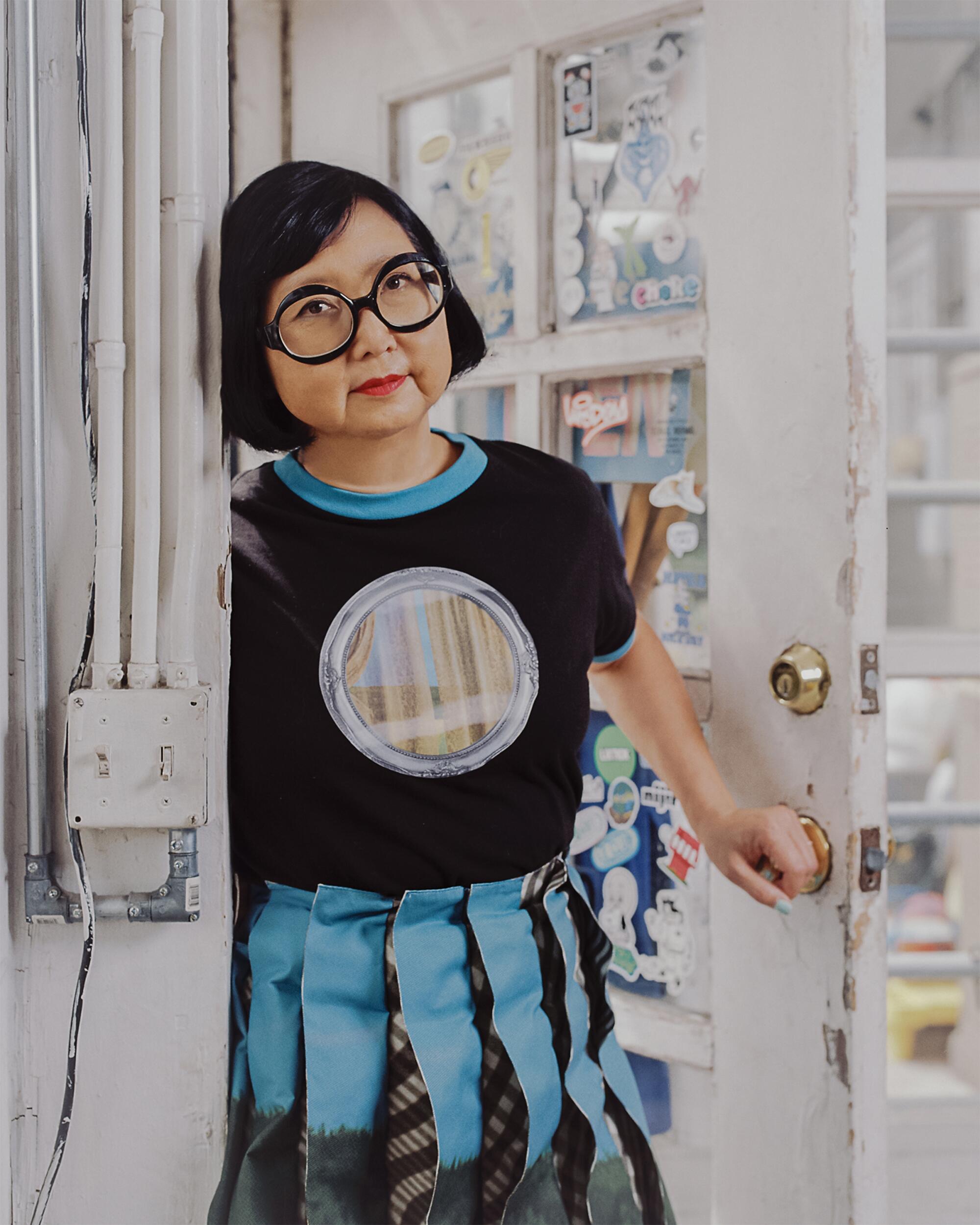
Shirley wears Leeann Huang t-shirt, skirt and shoes, We Love Colors tights and l.a. Eyeworks glasses here and in photos below.
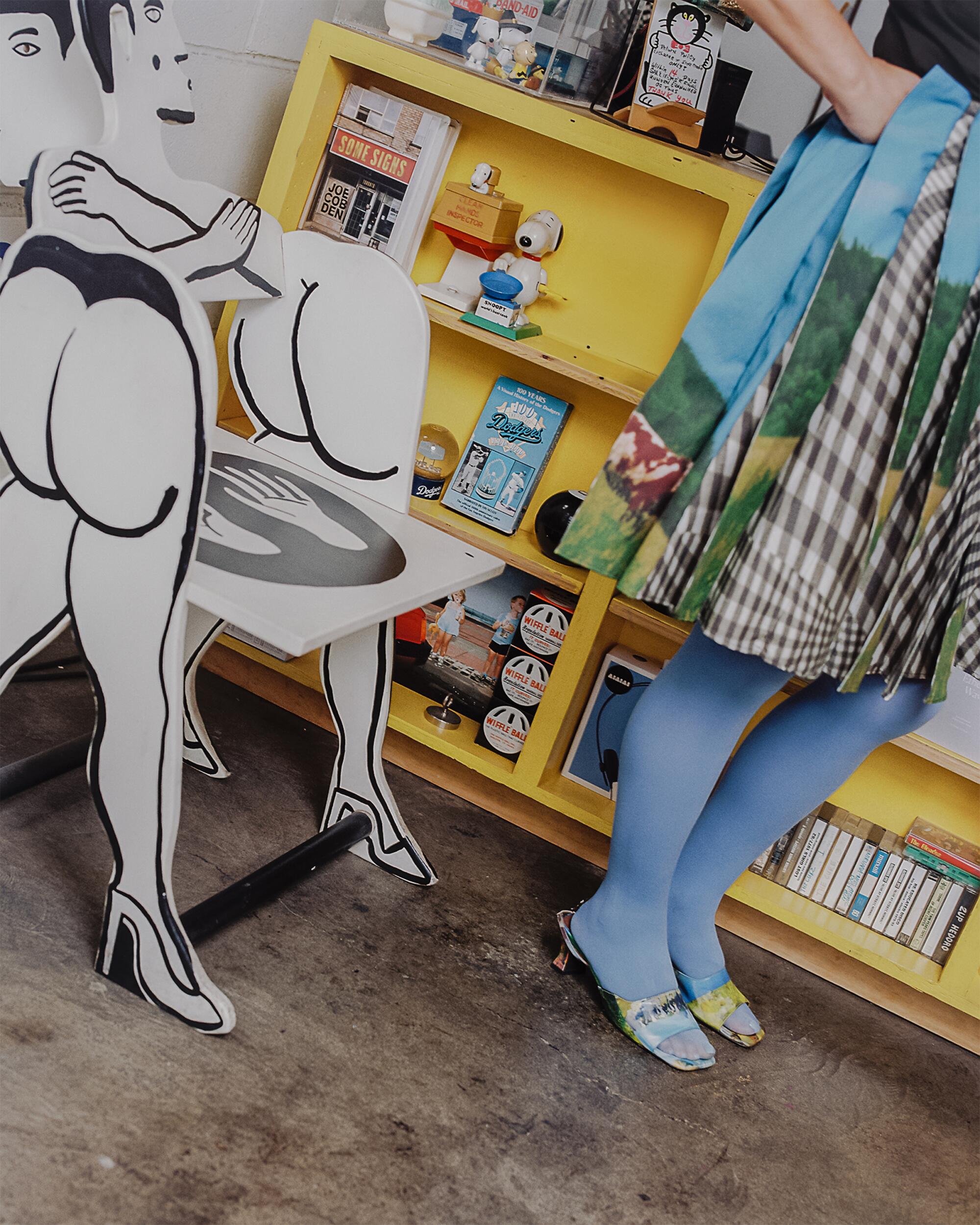
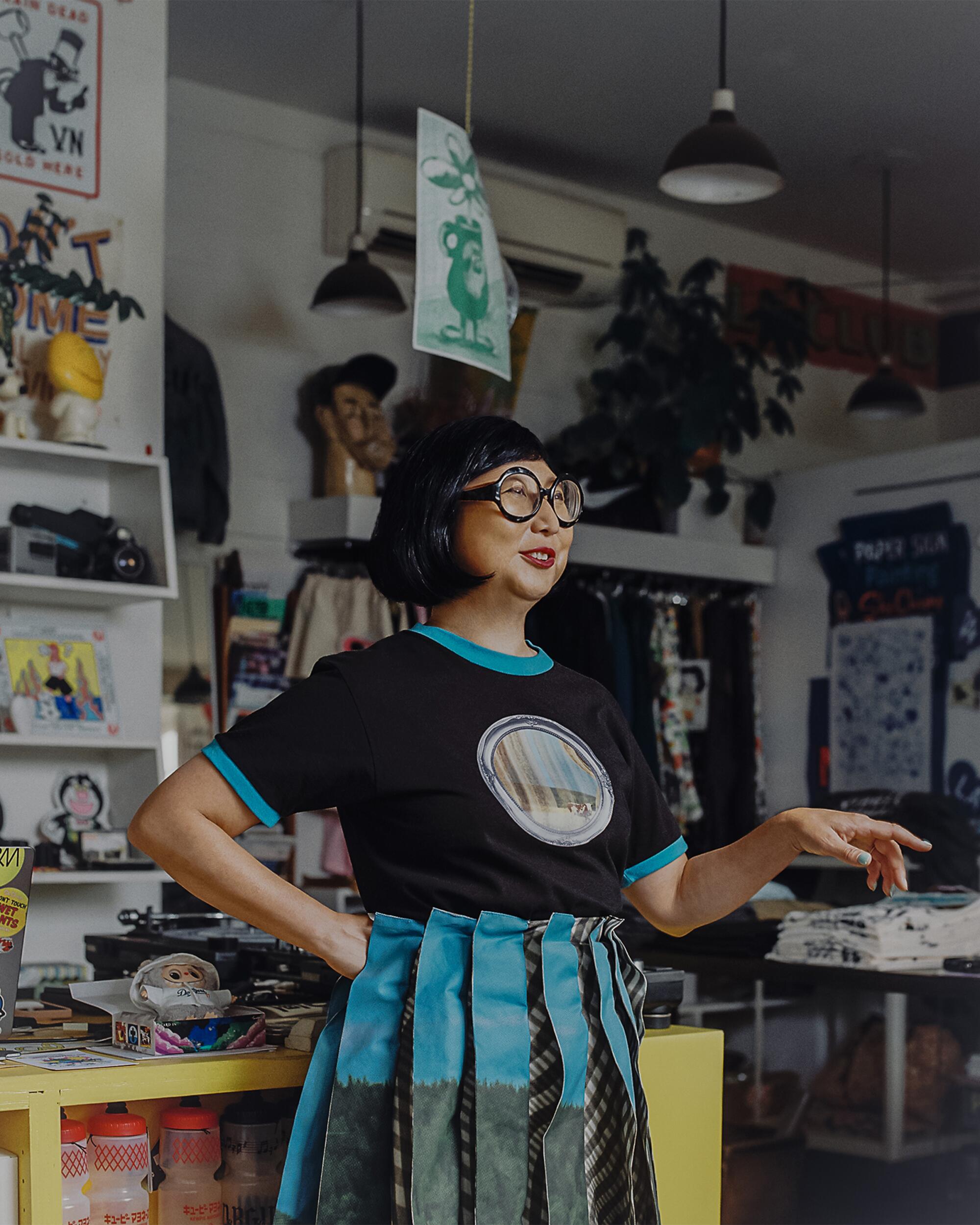
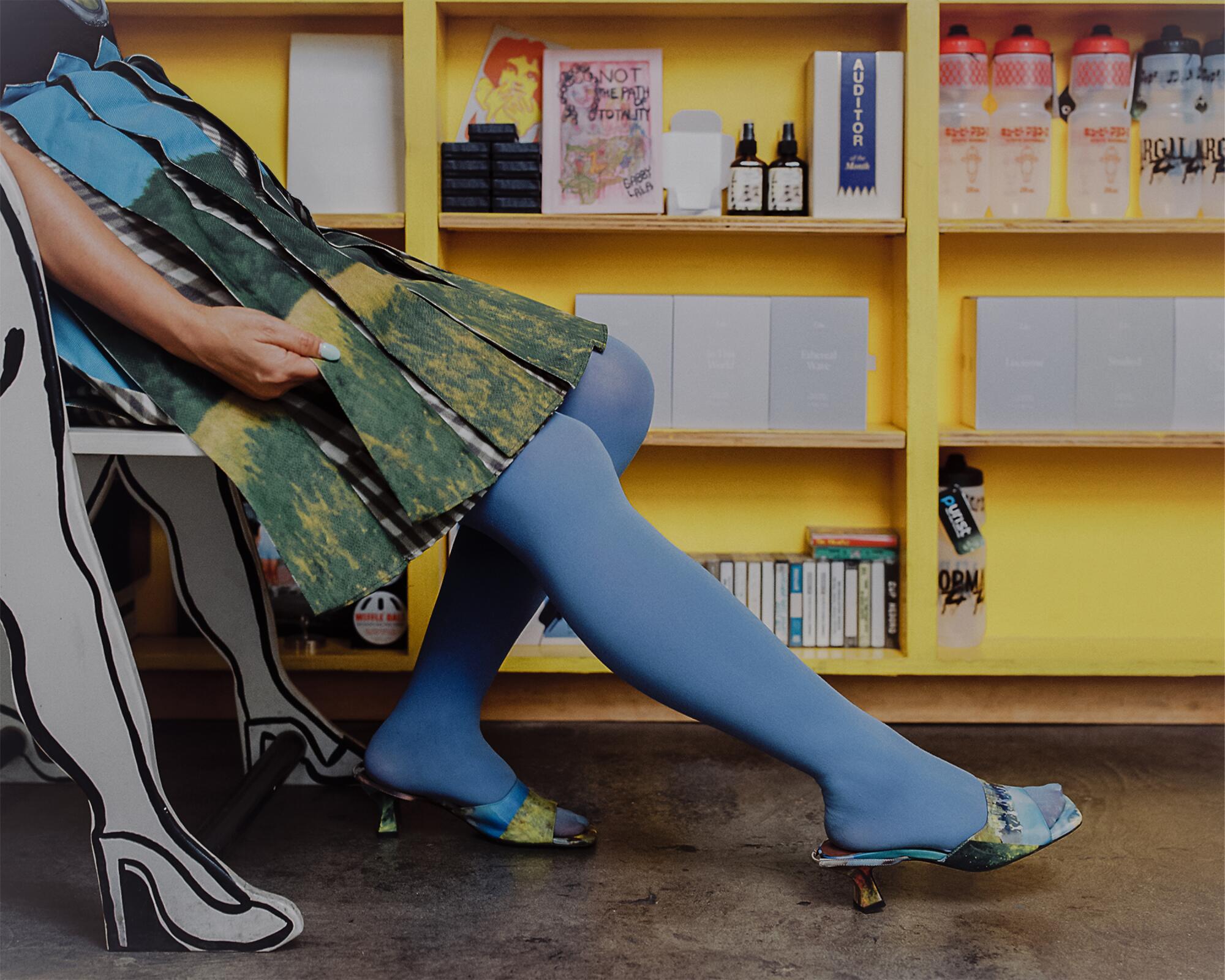
“She’s like a peacock. It’s not like she’s trying to get attention. But she has her own vision and doesn’t really care what’s going on. She knows what’s cool,” says Staunton, who cites Kurata as the biggest “inspiration” for the store.
Inside the quaint red brick building, blue L.A. hats are embroidered to read “Larry David,” acrylic shelves are packed with Snoopy figurines (for display only), trays of l.a. Eyeworks frames fill the tables and each clothing tag is a different elaborate doodle illustrated by Staunton. He adds that everything in the store is meant to have a “rabbit hole” effect, where shoppers can give in to their curiosities.
“We wanted a place where like-minded people could come here and have it be a space to hang out. They don’t have to buy anything,” says Kurata. The attached patio is complete with a mural of a man floating in space, pipe in hand, and the coolers are still filled with chilled beers and sparkling waters from their most recent get-together. She tells me about how many times they’ve allowed musicians and artists to transform this peaceful outdoor space into a lively venue.
“Having that connection with a community of creatives in the city is essential. Having that sort of human interaction is really good for your soul, and for your creativity,” she shares. “Having this store has been one of the most fulfilling things that I’ve done, and it’s not like we’re not making a ton of money off it.”
From the cactus out front, which Kurata and Staunton planted themselves, to grabbing lunch at the taqueria down the street, she explains cultivating a space like this and being an active part of the neighborhood has made her into a more “enriched person.” Kurata, who is of Japanese descent, brings up the lesser known history of East Hollywood. In the early 1900s, the neighborhood, then called J-Flats, was where a sizable group of Japanese immigrants settled. It was once a bustling community with Japanese boarding houses that offered affordable rent and home-cooked meals. Today, only one of these properties is operating.
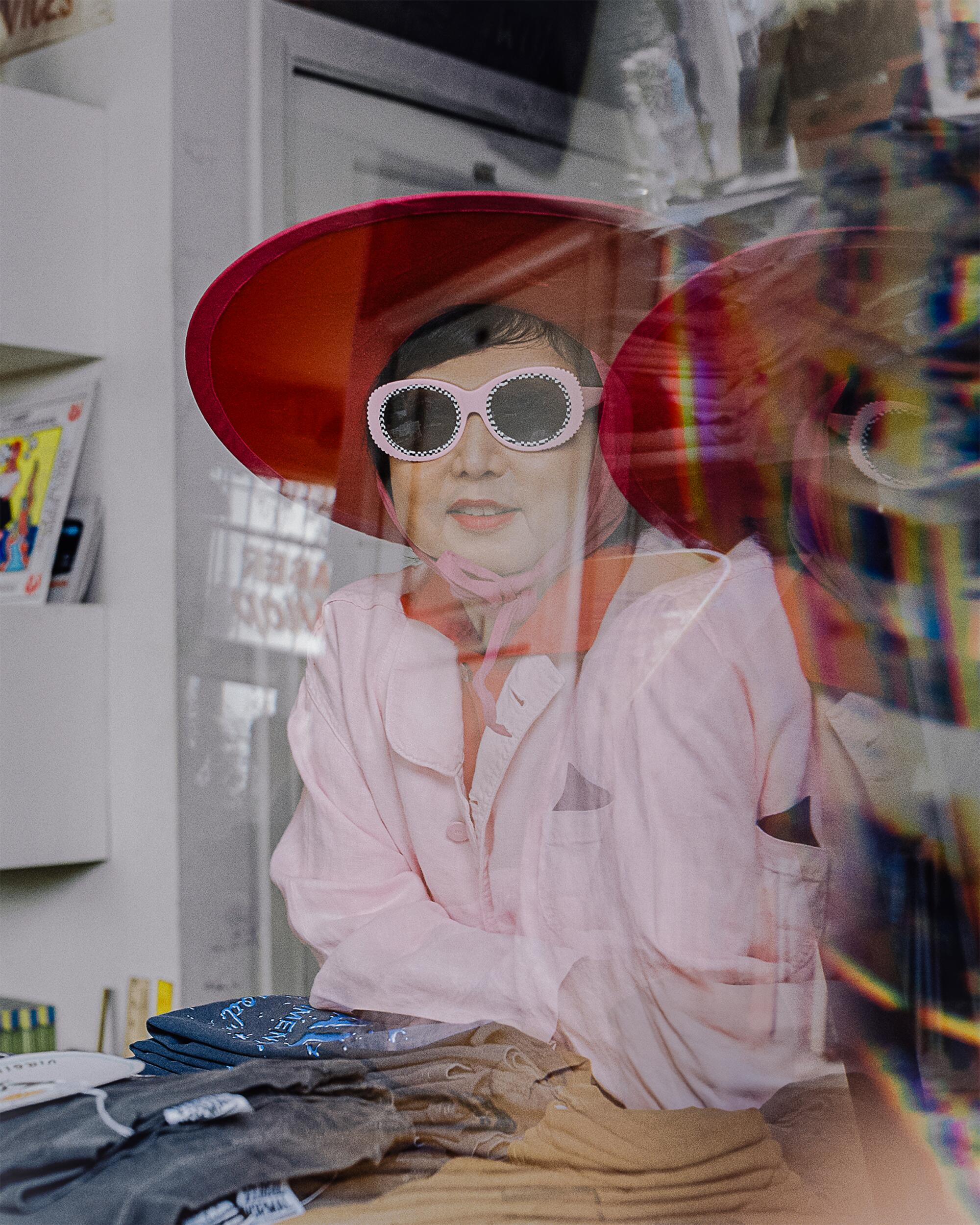
“Having that connection with a community of creatives in the city is essential. Having that sort of human interaction is really good for your soul, and for your creativity,”
For Kurata, being a part of this legacy means trimming the nearby overgrown vegetation to keep the sidewalks clear and running over to the locally owned convenience store when Virgil Normal needs supplies, instead of immediately turning to Amazon. She pours everything she learned from being raised in this city back into the store, and in turn, its surroundings.
Kurata was born and raised in Monterey Park, a region in the San Gabriel Valley with a primarily Asian population. The neighborhood is a small, homey stretch of land, known for its dining culture, hilly roads and suburban feeling (but not-so-suburban location). These days, she’ll often find herself in the area, as her mother and sister still live there. Together, they enjoy many of the surrounding dim sum-style restaurants.
Even from a young age, she was encouraged to treat the entire city as her stomping grounds. She attended elementary school in the Arts District, which she describes as quieter and “more industrial than it is today.” She also spent a lot of her childhood in Little Tokyo, shopping for Japanese magazines (where she found a lot of her early inspiration), playing in the arcade and grocery shopping with her family.
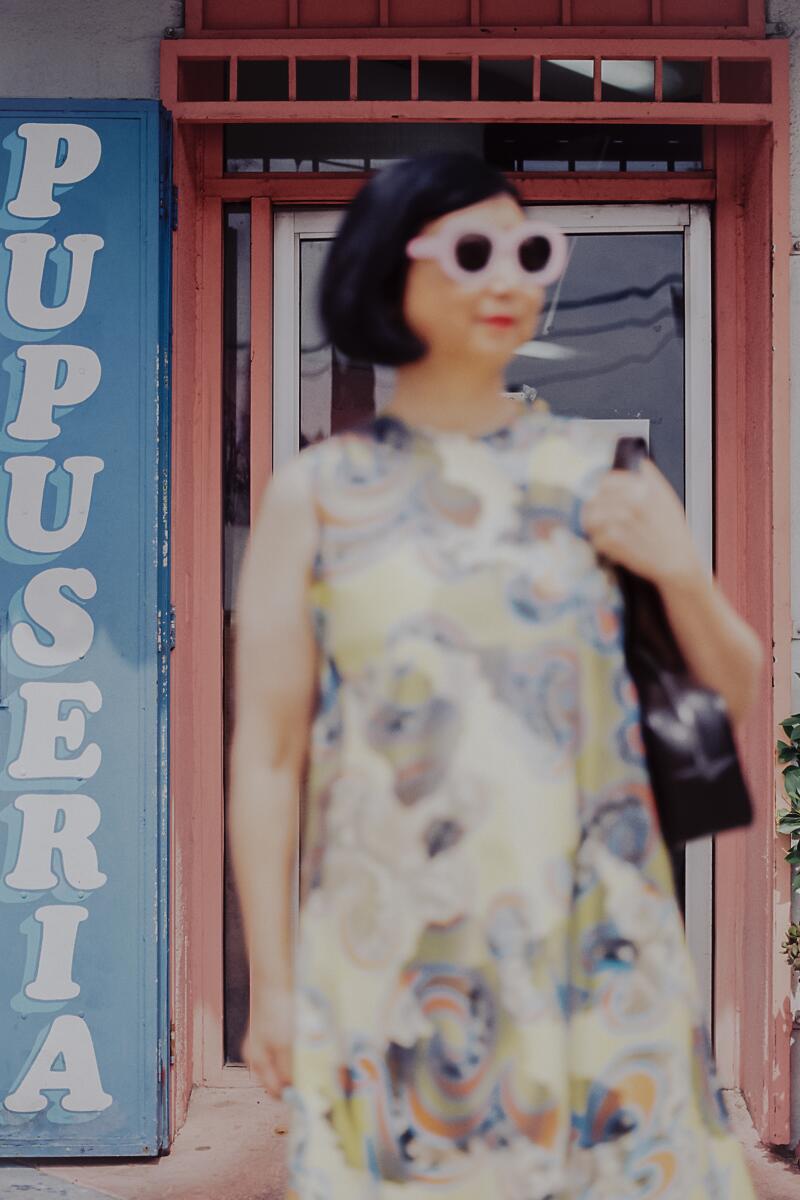
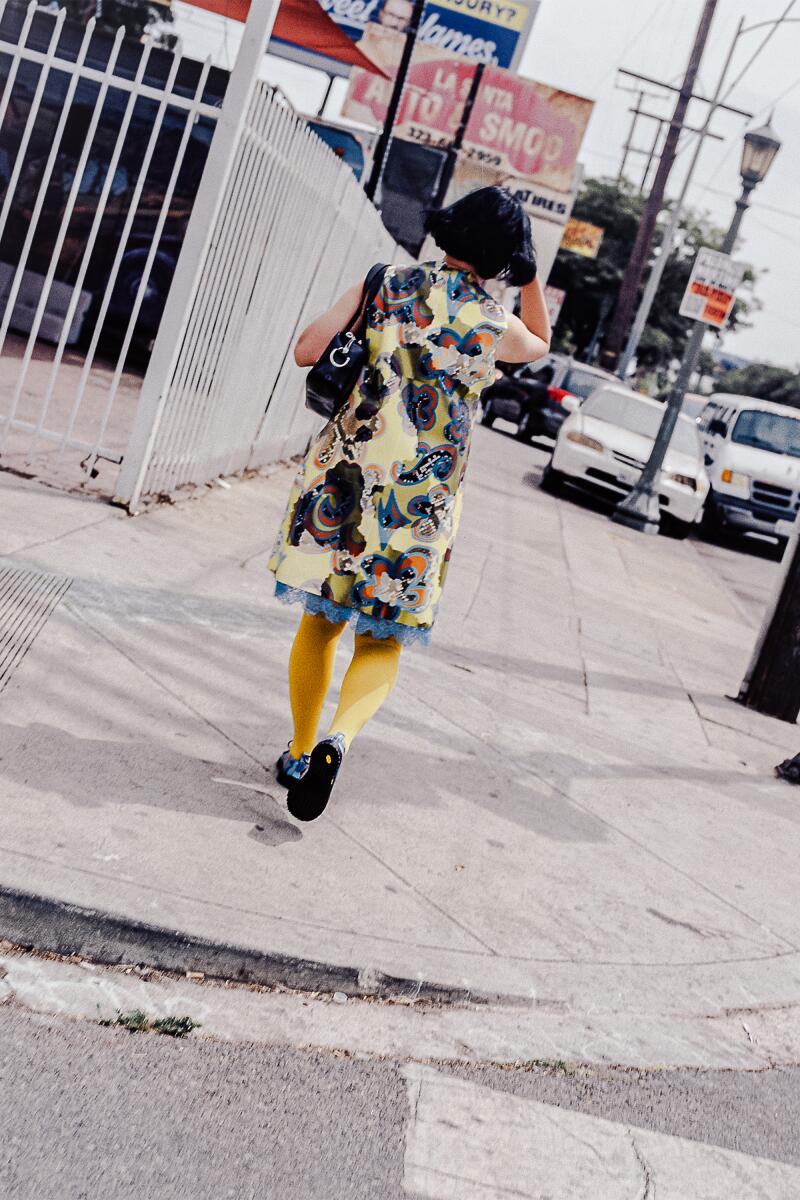
Shirley wears Leeann Huang lenticular dress and shoes, Mary Quant tights and l.a. Eyeworks sunglasses.
For high school, she decided to branch out even further, making the trek to an all-girls Catholic school in La Cañada Flintridge. “It was the first time where I felt like an outsider,” Kurata says, as she had only previously attended predominantly Asian schools. She laughs a little about being one of the rare “Japanese Catholics.”
“When you’re raised in something, you go along with it because your parents tell you, and it’s part of your education,” Kurata says. Her religious upbringing began to reach a point where she wasn’t connecting with it anymore. “Having that sort of awakening is good for you. I was able to look at myself, early in life, and realize that I don’t think this is for me.”
Her senior year, she discovered vintage stores. (She always knew that she had an affinity for clothing of the past, as she gravitated toward hand-me-down Barbies from the ’60s.) Her coming-of-age style consisted of layering skirts with other oversize pieces — and everything was baggy, “because it was the ’80s.” With this ignited passion for vintage and thrifting, Kurata began to mix items spanning across decades into one look.
“All the colors, the prints, the variety. It just seemed more fun. I would mix a ’60s dress with a jacket from the ’70s and maybe something from the ’40s,” says Kurata. It’s a practice that has remained a major part of her creative Rolodex.
Her lifelong interest in fashion led her to get a summer job at American Rag Cie on La Brea Avenue. At the time, the high-end store primarily sold a mix of well-curated timeless pieces, sourced from all over the world. It was the first time she encountered the full range of L.A.’s fashion scene. She worked alongside Christophe Loiron of Mister Freedom and other “rockabilly and edgier, slightly goth” kinds of people.
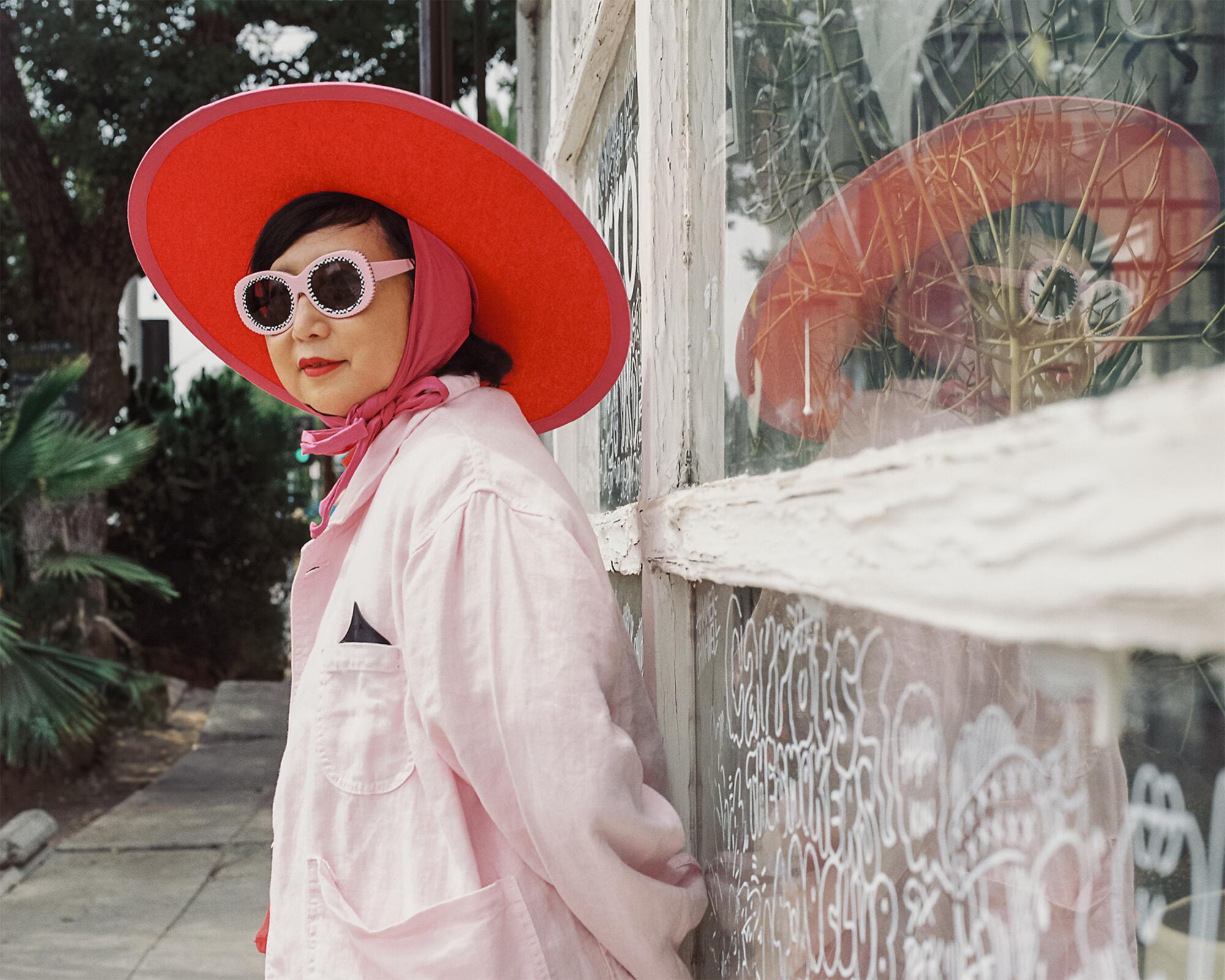
“Living abroad is such an important way of broadening your mind, being exposed to other cultures and even learning another language. It helps you grow as a person. It’s the best thing I ever did.”
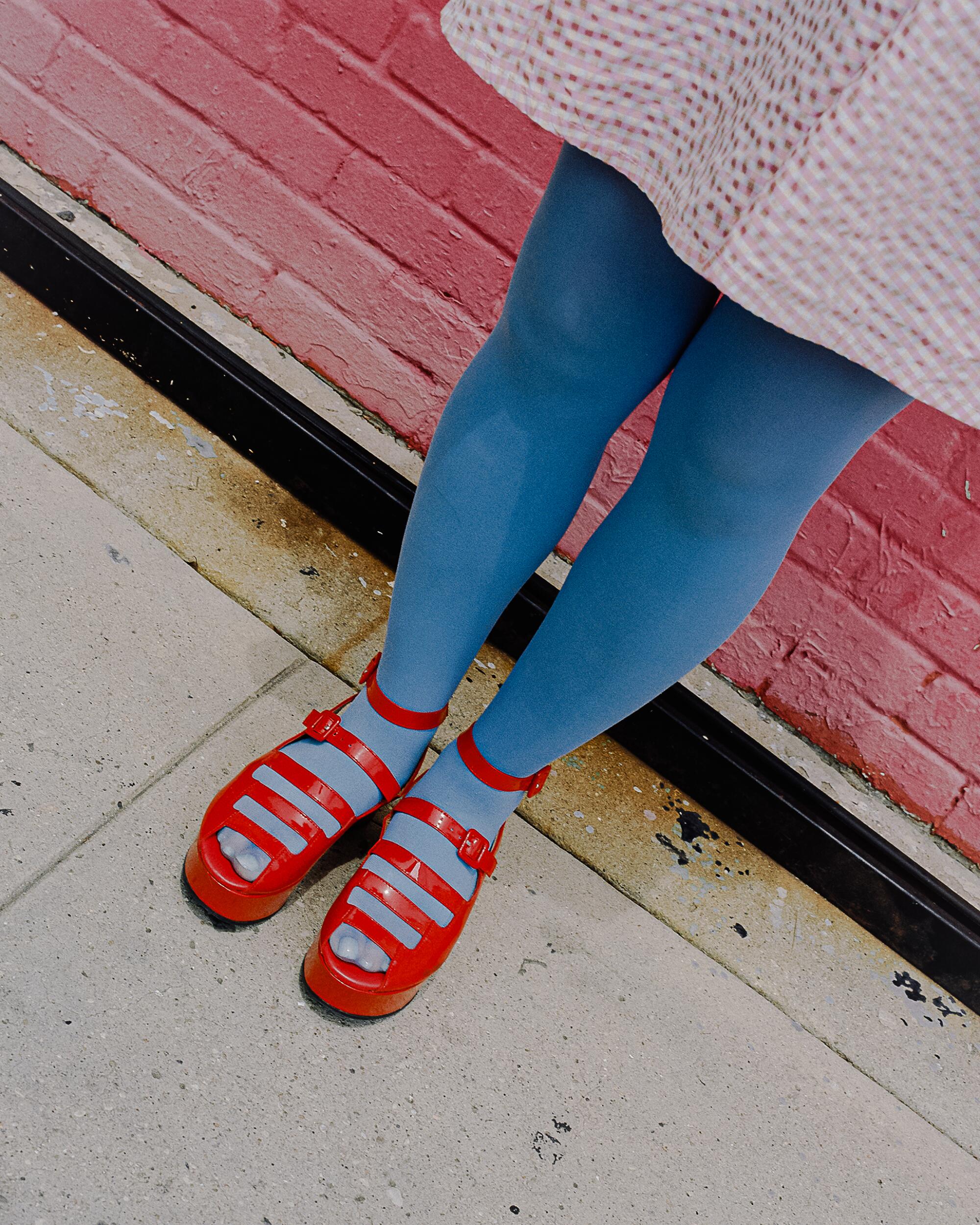
“Time moved really slowly in that place. But just the creativity that I was around, from both the people who worked there and shopped there, was great exposure,” says Kurata, who recalls seeing faces like Winona Ryder and Johnny Depp browsing the selection and Naomi Campbell and Christy Turlington trying on jeans.
Kurata continued her L.A. expedition to Cal State Long Beach, where she began her art degree. It wasn’t long before Studio Berçot, a now-closed fashion school in Paris known for its avant-garde curriculum, started calling her name.
“Living abroad is such an important way of broadening your mind, being exposed to other cultures and even learning another language. It helps you grow as a person,” says Kurata. “It’s the best thing I ever did.”
Her Parisian studies lasted around three years and it was the closest she had ever gotten to high fashion. Sometimes, she would be able to see runway shows by selling magazines inside the venue or volunteering to work backstage. Other times, she relied on well-intentioned shenanigans. She used to pass around and reuse an invitation within her group of friends. She once snuck in through a large, unattended hole in a fence. In one instance, she simply charged at the entrance when it began to rain. All things she did in the name of fashion.
“I would just do what I could to see as many shows as possible. All of the excitement is hard to explain. When I worked backstage, there’s this labor of love that’s put towards the show. It’s this contagious energy that you could feel when the models start coming,” says Kurata, who saw everything from Jean Paul Gaultier to John Galliano and Yves Saint Laurent. When she was backstage for a Vivienne Westwood show, she recollects seeing this “shorter model, and thinking, ‘Oh, she’s so tiny,’ and then realizing that it was Kate Moss who was still fairly new at that point.”
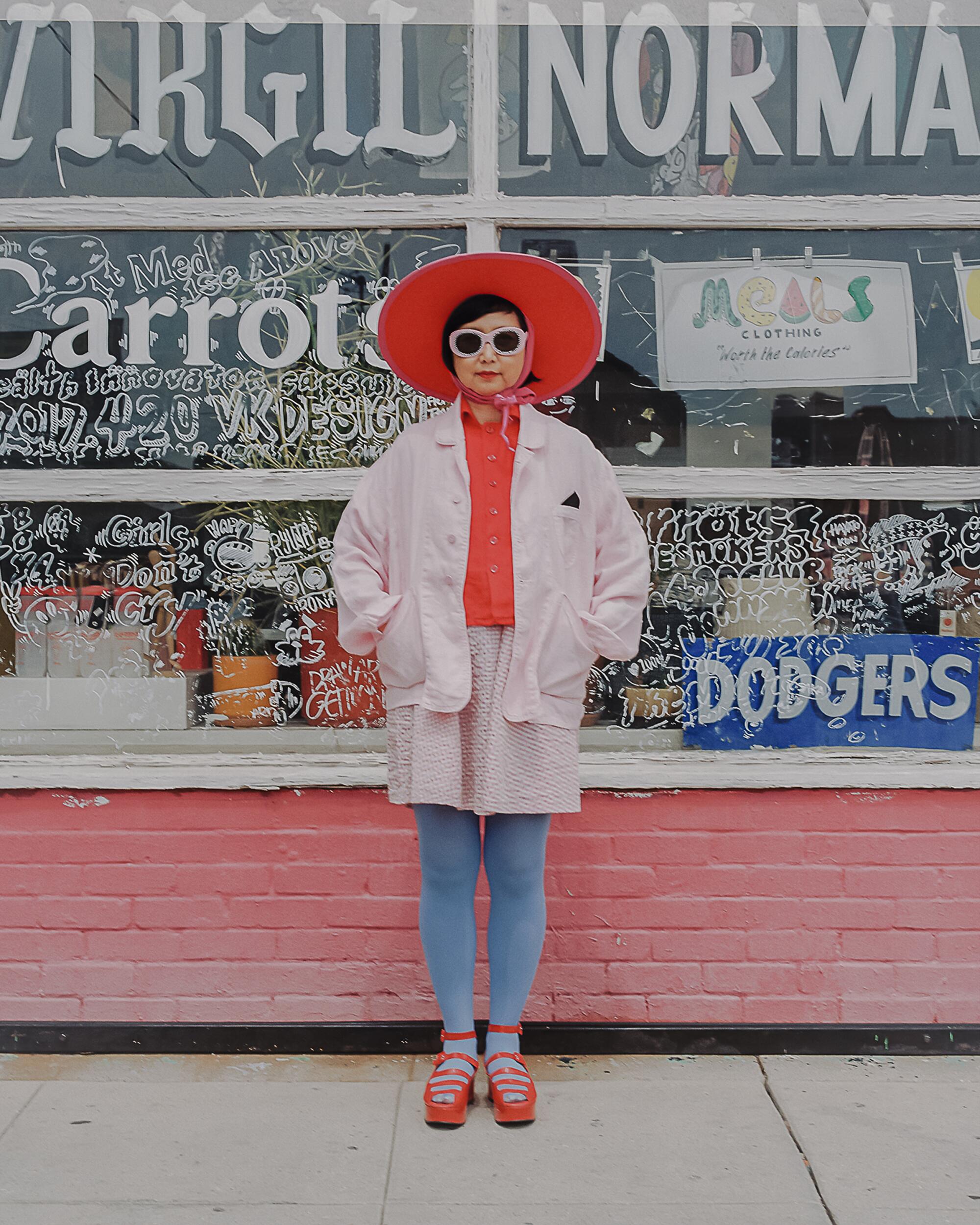
“We wanted a place where like-minded people could come here and have it be a space to hang out. Having this store has been one of the most fulfilling things that I’ve done.”
Staying in France was intriguing to a young Kurata, but the struggles of visas and paperwork deterred her. She instead returned to L.A., freshly inspired, and completed her bachelor’s degree in art (to her parents’ satisfaction). She didn’t plan to get into costume design, Kurata explains. But when it became clear that designing her own line would require moving to somewhere like New York or back to Europe, she realized, “Maybe fashion is not the world I want to get into; maybe it’s costumes.”
“I felt comfortable with that decision,” shares Kurata. “I do love film, so it was just a transition I made. It was still connected [to everything that I wanted to do].”
Without the aid of social media, she sent letters to costume designers, hoping to get mentored, and started working on low-budget jobs. She quickly fell in love with how much the job changed day-to-day. On occasion, there are 12-hour days that can be “miserable,” but her next job might be entirely different. One day she’s styling the seasonal campaigns for her longtime friends Kate and Laura Mulleavy, owners of Rodarte, and the next she could be styling for the cover of W Magazine, where a larger-than-life Jennifer Coolidge stomps through a miniature city in a neon polka-dot coat.
Whenever Kurata takes on a project, Staunton says she “just doesn’t stop.” Sometimes, he’ll wake up at 3 in the morning and she’s emailing people in Europe, attempting to hunt down a rare vintage piece. Her passion is the kind that simultaneously consumes and fuels her.
“There’s a lot of times [with her work] where I’m like, ‘That’s just straight out of Shirley’s closet.’ It’s not like she has to compromise. It’s something she would wear herself. She doesn’t have to follow trends,” explains Staunton. “People seek her out, because she has such a unique vision.”
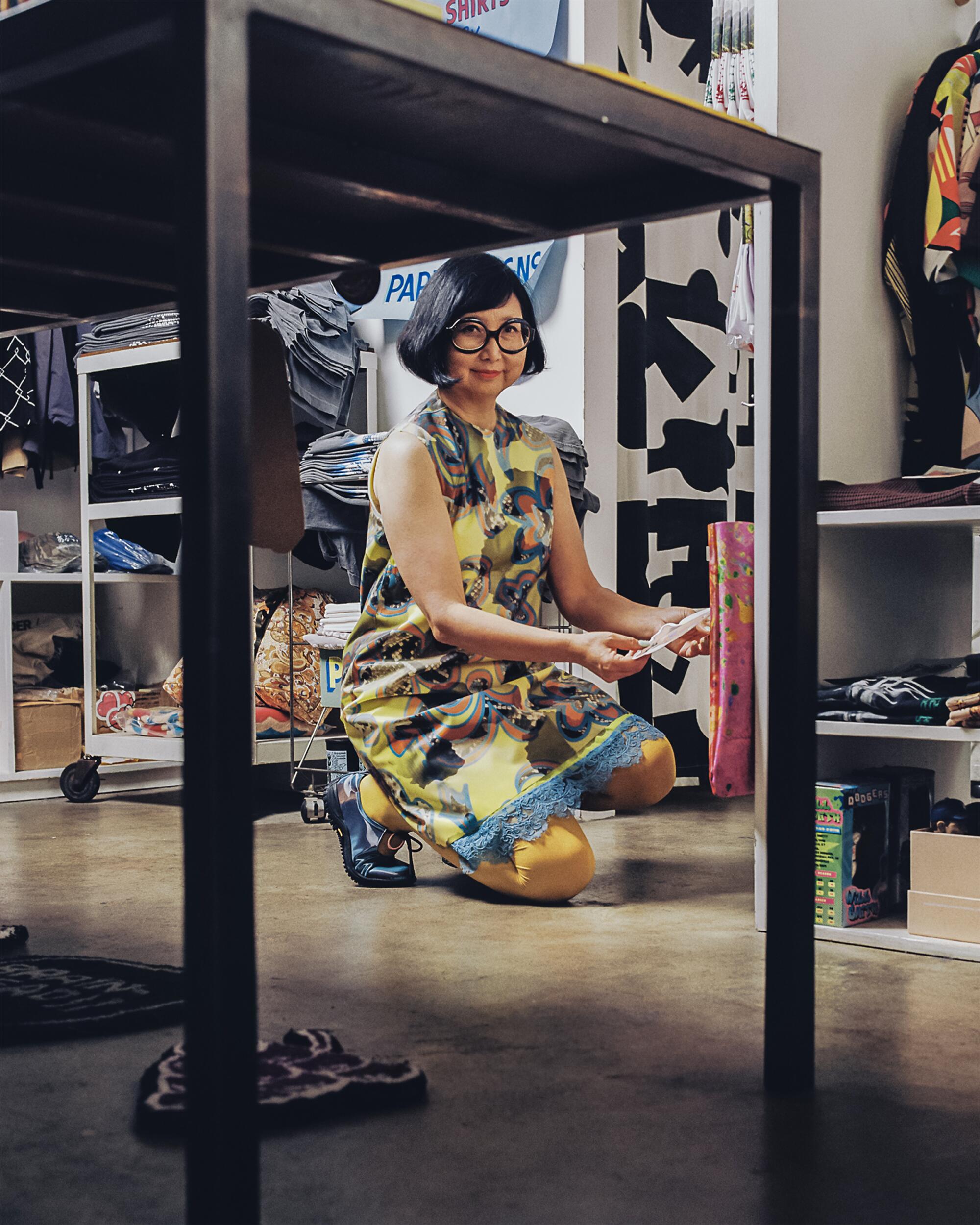
“I always tell people, L.A. is like going to a flea market. There’s some digging to do, but you’ll definitely find some gems.”
Kurata thinks of herself as “someone who gets bored easily.” It’s a quality that’s reflected in her eclectic style, busy travel schedule, Virgil Normal’s constantly changing selection and even the common feeling she gets when she’s sick of all of her clothes. It’s a good thing being bored and being in Los Angeles don’t go hand in hand.
I ask Kurata a somewhat daunting question for a born-and-bred Angeleno.
“Do you think you could ever see yourself calling another place home?”
She lets out a deep sigh and tells me it’s not something she’s closed off to. Though, she takes a moment to reflect on how everyone came together to provide support during the Palisades and Eaton fires earlier this year. Or how good it feels when they have events at Virgil Normal, to be surrounded by a diverse group of creative minds “who don’t judge.” She even thinks about how she currently lives in a Franklin Hills house, a neighborhood she never thought she would be able to afford.
Time and time again, Kurata and this sprawling city-state have looked out for each other. From the way she speaks of different areas with such an intrinsic care, to showcasing her unique creative eye in Tinseltown, L.A. has made her into a permanent seeker. Whether she chooses to stay in Franklin Hills for the rest of her life or packs up everything tomorrow, she’ll always keep an eye out for hidden gems — just like at the flea market.
